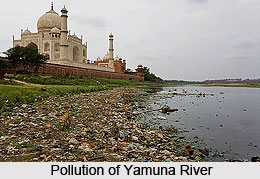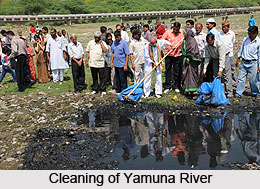 Pollution in Yamuna River has increased rapidly and the protection of this river includes
several governmental steps. Yamuna is unfortunately one of the most polluted rivers in
the world, especially in the banks near New Delhi, the capital of India. Almost 57% of
the citys waste is dumped into the river. Numerous attempts have been made to clean it;
however the efforts have brought few changes. In addition, the water in this river remains
torpid for almost 9 months in a year infuriating the situation.
Pollution in Yamuna River has increased rapidly and the protection of this river includes
several governmental steps. Yamuna is unfortunately one of the most polluted rivers in
the world, especially in the banks near New Delhi, the capital of India. Almost 57% of
the citys waste is dumped into the river. Numerous attempts have been made to clean it;
however the efforts have brought few changes. In addition, the water in this river remains
torpid for almost 9 months in a year infuriating the situation.
Pollution of Yamuna River
Yamunas water is distinguishable as "clear blue" as compared to silt-ridden yellow of
the Ganges. Due to high density population growth, rapid industrialization, today
Yamuna is terribly polluted. Delhi alone debouches around 3,296 MLD (million litres per
day) of dirt in the river. This makes harms to aquatic life and depletes oxygen level
resulting into bad odours and turbidity. The river water is suitable due to pollution, for
uses like drinking, outdoor bathing, propagation of aquatic life, irrigation and industrial
purposes.
Industrial pollution affects oxygen, temperature & pH etc. Large and medium industrial
units - 22 in Haryana, 42 in Delhi and 17 in Uttar Pradesh have been accused as
directly discharging and polluting the river Yamuna under the Action Plan area.
 Protection of Yamuna River
Protection of Yamuna River
The government of India has prepared elaborate plans to reconstruct and revamp the
sewage system and also the drainage system that empty into the river. In the context of
river pollution, certain actions of cleaning river have been strictly taken by the Ministry
of Environment and Forests (MoEF) of the Government of India (GOI) in 12 towns of
Haryana, 8 towns of Uttar Pradesh and Delhi under an action plan called the Yamuna
Action Plan (YAP), which is being implemented since 1993 by the National River
Conservation Directorate (NRCD) of the Ministry of Environment and Forests.
The Japan Bank for International Cooperation (JBIC) also participates actively in the
Yamuna Action Plan in 15 of the above 21 towns, excepting the 6 towns of Haryana
included later on the direction of the honourable Supreme Court of India. In August
2009, he Delhi Jal Board (DJB) prompted its plan for resuscitating the Yamuna?s 22 km
stretch in Delhi by constructing interceptor sewers.















